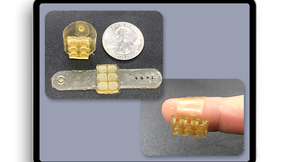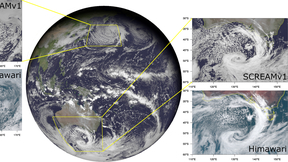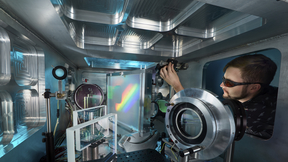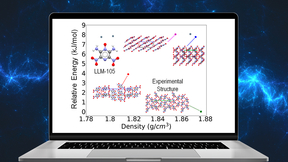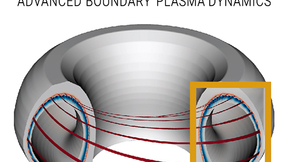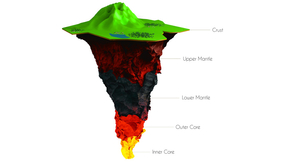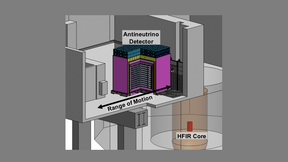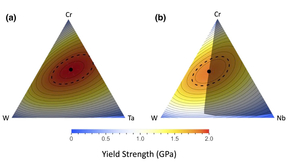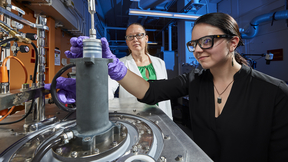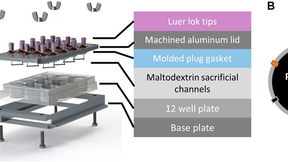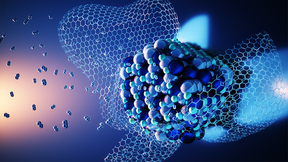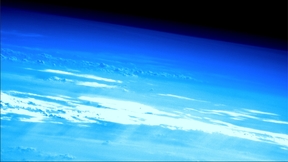Back
Physical and Life Sciences
LLNL and Meta engineers develop 3D-printed material with potential for more lifelike wearables
Engineers and chemists at Lawrence Livermore National Laboratory (LLNL) and Meta have developed a new kind of 3D-printed material capable of replicating characteristics of biological tissue, an advancement that could impact the future of “augmented humanity.” In a paper recently published in the journal Matter, LLNL and Meta researchers describe a framework for creating a …
LLNL scientists among finalists for new Gordon Bell climate modeling award
A team from Lawrence Livermore National Laboratory (LLNL) and seven other Department of Energy (DOE) national laboratories is a finalist for the new Association for Computing Machinery (ACM) Gordon Bell Prize for Climate Modeling for running an unprecedented high-resolution global atmosphere model on the world’s first exascale supercomputer. The Gordon Bell submission, led…
LLNL’s Jupiter Laser Facility funding renewed for additional research in discovery science
The Department of Energy’s Office of Science recently announced $28.5 million for LaserNetUS to advance discovery science and inertial fusion energy. Lawrence Livermore National Laboratory (LLNL) is one of nine facilities operating high-intensity, ultrafast lasers that will receive additional funding. LaserNetUS is North America's high intensity laser research network…
New chemistry leads to more robust carbon capture materials
In a significant stride toward implementing scalable climate solutions, Lawrence Livermore National Laboratory (LLNL) scientists have uncovered how some carbon capture materials have improved lifetime compared to others. These materials are key in addressing greenhouse gas emissions and global warming concerns. Researchers have shed light on the mechanism that empowers…
Breaking down barriers: Sharee Harris shares her career story
A common misconception is that those interested in technical roles at a national laboratory must hold a graduate degree such as a Ph.D. On the contrary, roughly 40% of the science, technology and engineering workforce at Lawrence Livermore National Laboratory (LLNL) claim an associate’s or bachelor’s degree as their highest education level. This false narrative is…
Matter at extremes: a question of scale
Scaling laws are like a secret code used across science to break down complex phenomena into simple mathematical expressions. These equations help us to understand how one factor in a system relates to other factors that determine the system’s behavior. For example, Kleiber’s Law, one of the best-known scaling laws, observes that metabolic rates of many organisms — from…
New Lab projects to promote STEM diversity, accelerate battery research
Lawrence Livermore National Laboratory (LLNL) will partner with outside institutions to improve diversity in the STEM workforce and provide training to underrepresented students and researchers under a pair of projects recently funded by the Department of Energy. With support from DOE’s Funding for Accelerated, Inclusive Research (FAIR) initiative, LLNL will partner with…
Understanding the plasticity of diamond for improved fusion ignition
Alex Li, a Lawrence Livermore National Laboratory (LLNL) summer student in the Computational Chemistry and Materials Science Summer Institute, recently led a study published in the journal Matter to investigate the evolution of plasticity in diamond along different loading orientations and the effects that voids (pores) within the material can have on stresses within the…
New research shows successful ab initio crystal structure prediction of energetic materials
New research by Lawrence Livermore National Laboratory researchers and collaborators from Carnegie Mellon University (CMU) demonstrates that crystal structure prediction is a useful tool for studying the various ways the molecules can pack together, also known as ubiquitous polymorphism, in energetic materials. The research also shows promise of becoming an integral part…
LLNL-led project to advance understanding of plasma dynamics for future fusion power plants
A Lawrence Livermore National Laboratory-led project aimed at using computing tools to improve understanding of fusion plasma dynamics was among 12 projects recently awarded funding by the Department of Energy (DOE) to accelerate fusion power plant development. The four-year, multi-institutional Advanced Boundary Plasma Dynamics (ABOUND) project will receive $9.25 million…
LLNL develops portable Thomson scattering diagnostic to support ARPA-E’s fusion energy ventures
Scientists at Lawrence Livermore National Laboratory (LLNL) collaborated with University of California San Diego (UCSD) to design, assemble, and field a portable optical Thomson scattering diagnostic system for the Advanced Research Projects Agency-Energy (ARPA-E) — a Department of Energy agency which supports private companies that are developing new ways to generate,…
Iron monoxide in Earth’s deep interior
Iron monoxide (FeO), also known as wüstite in its mineral form, is a significant (even if not predominant) component of Earth’s core and the deep interior of Earth and other planets. Most notably, FeO exhibits a richness of condensed-matter phenomena, including crystal-structural phase transformations and melting, electronic transitions, and spin-state transitions that…
Measuring the antineutrino energy spectrum
Nuclear reactors, among the brightest terrestrial emitters of antineutrinos, have been central to neutrino physics. For more than a decade, physicists have puzzled over anomalous differences between measurements and predictions of the antineutrino emissions from nuclear reactors. These differences could reveal deficiencies in prediction methods and their underlying nuclear…
Versatile cold spray for a greener economy
Permanent magnets form the backbone of clean energy technologies from direct-drive wind turbines to electric motors, and will form a key component of the upcoming transition to a green economy. There is significant interest in the application of additive manufacturing approaches to produce permanent magnets, with techniques such as laser powder-bed fusion and binder-jet…
Overlapping genes for prolonged genetic circuit stability
For the past several decades, synthetic biologists have sought to genetically engineer microorganisms for a wide range of application—including therapeutics discovery and delivery, drug manufacturing, agricultural yields, biofuel production, mineral extraction, and waste degradation. This is achieved through the design of genetic circuits, which are made up of DNA parts…
Designing materials for high-temperature structural applications
A materials science team, led by postdoctoral researcher Kate Elder, recently published a two-part series in npj Computational Materials. The research focuses on the computational discovery of ultra-strong, stable, and lightweight refractory metal-based multi-principal element alloys (MPEAs), which are compelling materials for high-temperature structural applications…
Georgia Tech duo spends summer at LLNL exploring materials processing and manufacturing
Professor Blair Brettmann from the Georgia Institute of Technology and her doctoral student Alexa Dobbs decided to spend a summer at Lawrence Livermore National Laboratory (LLNL) to collaborate with the Lab’s materials science experts and learn more about LLNL’s experimental resources. During Brettmann’s faculty mini-sabbatical, she collaborated with researchers from LLNL…
Platform tests colorectal cancer therapies in vitro
Colorectal cancer (CRC) — cancer of the colon or rectum — is the third-most common cancer in both men and women in the United States and the second-most common cause of cancer-related death in developed countries. Although surgery is highly successful for patients with a localized disease or disease confined to a narrow region (stages I–III), a total of 60% of CRC patients…
New composite may be key to improved hydrogen storage
Lawrence Livermore National Laboratory (LLNL) computational scientists worked with experimental collaborators at Lawrence Berkeley and Sandia national laboratories to design metal amide-based composites capable of overcoming key kinetic limitations in their performance as hydrogen storage materials. Hydrogen possesses the highest energy density of any chemical fuel and can…
LLNL’s prototype telescope now fully operational aboard the International Space Station
When SpaceX’s Dragon spacecraft docked with the International Space Station (ISS) on March 16, it delivered several thousand pounds of supplies for the crew as well as new hardware. The hardware included the U.S. Space Force’s Space Test Program Houston 9 (STP-H9) platform, which houses a prototype telescope designed and built by Lawrence Livermore National Laboratory's…


